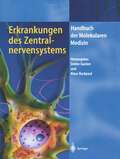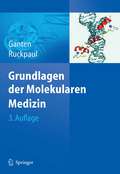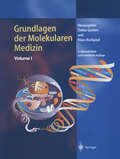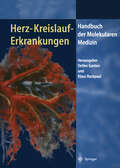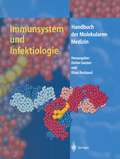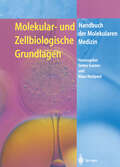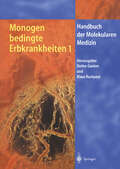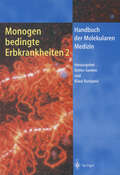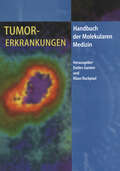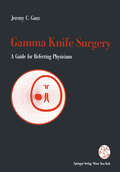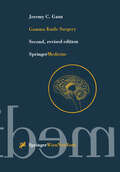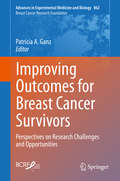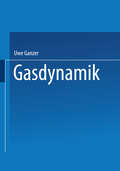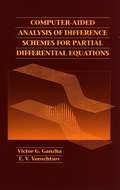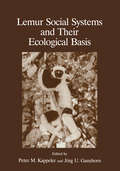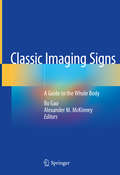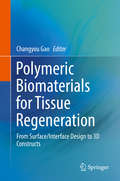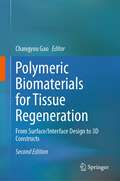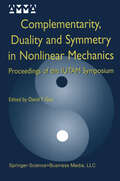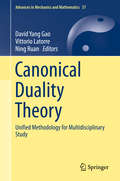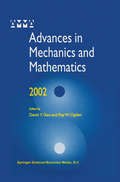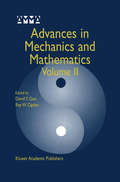- Table View
- List View
Erkrankungen des Zentralnervensystems (Handbuch der Molekularen Medizin #5)
by Detlev Ganten Klaus RuckpaulMolekularbiologie und molekulare Genetik haben entscheidend zur Aufklärung bisher unklarer Erkrankungen des ZNS beigetragen. Ausgewiesene Experten stellen die molekularen Ursachen, Diagnostik und Therapie u.a. bei multipler Sklerose, Alzheimer, Enzephalopathie bei Aids, Sucht und Depression dar. Concise text: Ausgewiesene Experten stellen die molekularen Ursachen, Diagnostik und Therapie u.a. bei multipler Sklerose, Alzheimer, Enzephalopathie bei Aids, Sucht und Depression dar.
Grundlagen der Molekularen Medizin
by Detlev Ganten Klaus RuckpaulDas Wissen über die molekularen Grundlagen der Medizin und seine Anwendung in der klinischen Medizin nimmt mit ungebrochener Dynamik zu. Die 3. Auflage des Buches reflektiert diese Entwicklung: In 22 Kapiteln werden allgemeine Grundlagen, experimentelle Modelle, Diagnostik und Therapie auf dem neuesten Kenntnisstand von ausgewiesenen Experten dargestellt. Neu hinzugekommen sind Kapitel über die Themen, deren zentrale Bedeutung für die Zukunft der Molekularen Medizin absehbar ist: Pharmakogenetik, Pharmakogenomik, Gentherapie, Bioinformatik und biotechnologische Anwendungen. Die ideale Wissensgrundlage für Interessierte aus allen Fachgebieten, die an den Fortschritten der Molekularen Medizin teilhaben wollen!
Grundlagen der Molekularen Medizin
by Detlev Ganten Klaus RuckpaulDie Zunahme unserer Kenntnisse über die molekularen Mechanismen u.a. von Wachstums-, Entwicklungs- und Differenzierungsprozessen hat die Grundlagen der molekularen Medizin innerhalb weniger Jahre erheblich erweitert. In besonderer Weise hat die Aufklärung der Basensequenz des menschlichen Genoms zu dieser Entwicklung beigetragen und die Bildung neuer Forschungsfelder wie Genomics und Proteomics ausgelöst. Die vorliegende Neuauflage der molekular- und zellbiologischen Grundlagen der Molekularen Medizin will diesen Fortschritt begleiten. In 24 Kapiteln wird der aktuelle Kenntnisstand der Molekularen Medizin von ausgewiesenen Experten dargestellt. Dieser Band sei all denen empfohlen, die als Biowissenschaftler - seien es Mediziner, Biologen, Biochemiker oder Biophysiker - an diesem Fortschritt teilhaben wollen.
Herz-Kreislauf-Erkrankungen (Handbuch der Molekularen Medizin #3)
by Detlev Ganten Klaus RuckpaulDie Kenntnis molekulargenetischer Zusammenhänge bei Herz-Kreislauf-Erkrankungen ermöglicht eine frühe Diagnostik und damit eine individuelle Prävention und Therapie. Das Themenspektrum zeigt, wie molekularbiologische Techniken bereits heute für eine erfolgreiche Behandlung eingesetzt werden können.
Immunsystem und Infektiologie (Handbuch der Molekularen Medizin #4)
by Detlev Ganten Klaus RuckpaulDie Zunahme von Infektionskrankheiten und eine wachsende Erreger-Resistenz machen das Thema besonders aktuell. Im Mittelpunkt des Bandes stehen die Pathologie des Immunsystems, die molekularen Ursachen immunologischer Erkrankungen und die heute mögliche molekularmedizinische Diagnostik und Therapie. Concise text: Topaktuelles Thema im Kampf gegen Infektionskrankheiten und Erreger-Resistenz: Alles über die Möglichkeiten der molekularmedizinischen Diagnostik und Therapie bei Immun- und Infektionskrankheiten.
Molekular- und Zellbiologische Grundlagen (Handbuch der Molekularen Medizin #1)
by Detlev Ganten Klaus RuckpaulDas Handbuch liefert Ihnen Band für Band die Bausteine des modernen Wissens. Es eröffnet Ihnen den Zugang zur molekularen Medizin und zu ihren faszinierenden diagnostischen und therapeutischen Möglichkeiten. Jeder Band stellt Ihnen die modernen Erkenntnisse und das praxisorientierte Wissen zur Verfügung, das Ihren medizinischen Alltag zunehmend bestimmen wird.Ihre Vorteile:Informationsvorsprung auf einem zukunftsweisenden Gebiet der Medizin; Diagnostische und therapeutische Kompetenz in aktuellen Praxisfragen; Sichere Orientierung bereits in der AusbildungDer erste Band führt Sie systematisch in die allgemeinen Grundlagen der molekularen Medizin ein. Dieses Grundlagenwissen vermittelt Ihnen das Verständnis für die Behandlungskonzepte, die im Mittelpunkt der weiteren Bände stehen.Ein Wissensspeicher, auf den Sie nicht verzichten können. Sichern Sie sich Ihren Informationsvorsprung, und profitieren Sie Band für Band von dem günstigen Vorbestellpreis!
Monogen bedingte Erbkrankheiten 1 (Handbuch der Molekularen Medizin #6)
by Detlev Ganten Klaus RuckpaulVererbbare Krankheiten sind erst seit wenigen Jahren Forschungsgegenstand der molekularen Medizin. Das Handbuch faßt die aktuellen Erkenntnisse zusammen und behandelt praxisgerecht die modernen gentechnischen Möglichkeiten der Diagnostik und Therapie. Dabei reicht das Themenspektrum von neuromuskulären Erkrankungen bis hin zu Repeat-Sequenz-Expansions-Syndromen.An Ihren klinischen Belangen orientiert:- Gegenüberstellung konventioneller und molekularmedizinischer Therapiestrategien- Interpretation der Forschungsergebnisse- verständliche Einführung in moderne gentechnische Methoden Das Handbuch bietet Ihnen hochaktuelles Wissen, das Ihren medizinischen Alltag zunehmend bestimmen wird.
Monogen bedingte Erbkrankheiten 2 (Handbuch der Molekularen Medizin #7)
by Detlev Ganten Klaus RuckpaulDer Band eröffnet den Zugang zu einem faszinierenden Gebiet der molekularen Medizin. Anerkannte Experten stellen umfassend die modernen Erkenntnisse über die molekularen Grundlagen von Erbkrankheiten dar:Wissenschaftlich fundiert- Erkrankungen der Augen, der Mundhöhle und des Kiefers, der Haut und des Skelettsystems bis zu erblichen NierenerkrankungenPraxisorientiert- Wichtige Aspekte bei der Beratung von betroffenen Patienten- Aktueller Stand der GentherapieDamit ergänzt der Band die Darstellung monogen bedingter Erbkrankheiten in Band 6.Das Werk macht eindrucksvoll die Fortschritte gendiagnostischer Analysen und die Möglichkeiten einer vorsorgenden Therapie deutlich.
Tumorerkrankungen (Handbuch der Molekularen Medizin #2)
by Detlev Ganten Klaus RuckpaulLernen Sie eine neue Generation diagnostischer und therapeutischer Prinzipien kennen.Das Handbuch der Molekularen Medizin liefert Ihnen Band für Band die Bausteine des modernen Wissens. Es eröffnet Ihnen der Zugang zur molekularen Medizin und zu ihren faszinierenden diagnostischen und therapeutischen Möglichkeiten.Ihre Vorteile:o Informationsvorsprung auf einem zukunftsweisenden Gebiet der Medizino Diagnostische und therapeutische Kompetenz in aktuellen Praxisfrageno Sichere Orientierung bereits in der Aus- und FortbildungDer Band Tumorerkrankungen vermittelt Ihnen an ausgewählten Beispielen neue molekulare und genetische Erkenntnisse für die Behandlung von Krebserkrankungen.- Diagnostik, Therapie, Prävention- Klinische Anwendung der Gentherapie- Problemstellungen und ärztliche VerantwortungSichern Sie sich modernes Praxiswissen, das Ihren medizinischen Alltag zunehmend bestimmen wird.
2021 International Conference on Development and Application of Carbon Nanomaterials in Energetic Materials (Springer Proceedings in Physics #276)
by Alon Gany Xiaolong FuThis book features selected papers presented at the 2021 International Conference on Development and Application of Carbon Nanomaterials in Energetic Materials. It discusses the latest progress in the field of advance carbon nanomaterials in energetic materials; including the structural design, theoretical calculation, synthesis, properties, and applications of carbon materials. It also presents the new technology and applications of advanced carbon nanomaterials in energetic materials. It can be used as a reference book for researchers in energetic materials and related fields. It is also be useful for undergraduates and postgraduates studying these topics.
Gamma Knife Surgery: A Guide for Referring Physicians
by Jeremy GanzRadiosurgery has become an established technique, with more than 15000 patients treated world-wide, most of them in the last five years. Yet, there is much uncertainty in the general medical community as to the nature, advantages and limitations of the method. This uncertainty provokes unnecessary debate between colleagues and is a source of avoidable stress to patients. This book provides an account of the scientific basis of radiosurgery and describes its current applications in respect of the only well established radiosurgical device, the Leksell Gamma Knife. The book assumes the general medical knowledge of a newly qualified medical practitioner. There are three sections. The first outlines the rationale for radiosurgery and the principles of stereotaxy, radiophysics and radiobiology. The middle section, consisting of a single chapter, describes what a potential patient may expect to experience. In the final section, the current applications are gone through, one by one, indicating what can and what cannot be achieved. The book is intended for neurologists, neurosurgeons, internists, otolaryngologists, oncologists, ophthalmologists, general practitioners, medical students and anyone else who might wish to refer a patient to or advise a patient about Gamma Knife radiosurgery.
Gamma Knife Surgery
by Jeremy GanzThis book attempts to combine many different threads into a comprehensible whole. Since the subject is the Gamma Knife and the author is a neurosurgeon, the field of clinical interest is restricted to intracranial pathology. The discipline of radiosurgery now applies to patients who may reasonably be referred by internists, neurologists, otolaryngologists, endocrinologists and several others. Some of the topics, touched upon, such as stereotaxy and the construction of a radio surgical instrument are unfamiliar to the majority of medical men. Other topics, such as those pertaining to the reactions between radiation and living tissue, are not exactly unfamiliar and yet, for most of us, they are not comfortable areas of expertise: in that we have some basic knowledge but not enough to draw conclusions and interpret. In particular, it is not easy to answer the very sensible questions that patients ask, when being considered for this particular form of treatment. The author has attempted to describe the basic relevant phenomenology in terms that should be readily understandable to a non-specialist physician. To do this, he has been heavily dependent on the expertise of a number of mathematically sophisticated collaborators, who have checked his manuscript. They are named in the acknowledgments section. The relevance of the different sections of this book will naturally be assessed differently, according to the experience and interest of the reader. To simplifY access to the information that is required, the book is divided into three main sections.
Improving Outcomes for Breast Cancer Survivors: Perspectives on Research Challenges and Opportunities (Advances in Experimental Medicine and Biology #862)
by Patricia A. GanzIn collaboration with the Breast Cancer Research Foundation (BCRF), this timely volume provides a comprehensive review on all areas of breast cancer survivorship research, highlighting research that is underway or in development. The range of topics covered include the biology and management of fatigue and cognitive dysfunction on breast cancer survivorship, the biology and management of Neuropathy and Arthralgias, the ongoing research on the biology of diet and lifestyle interventions in survivors, and more. With the tremendous growth in the number of breast cancer survivors, researchers have moved beyond describing the outcomes of breast cancer treatments and are focusing their research on understanding the mechanisms underlying the development of the late effects of breast cancer treatment, as well as the development and evaluation of interventions to mitigate some of the persistent symptoms—topics which are also explored in this volume. In addition, current research on how to improve survivorship and reduce recurrence of breast cancer through behavioral and lifestyle modifications is also discussed.
Versuche an Mauerwerksscheiben unter Normalkraft und Querkraft (Institut für Baustatik. Versuchsberichte)
by GANZ THÜRLIMANNGold: Lieferung 3 (Gmelin Handbook of Inorganic and Organometallic Chemistry - 8th edition #A-u / 1-3 / 3)
by Wilhelm Ganzenmuüller Hermann Gedschold Alfons Kotowski Leopold GmelinComputer-Aided Analysis of Difference Schemes for Partial Differential Equations
by Victor G. Ganzha E. V. VorozhtsovAdvances in computer technology have conveniently coincided withtrends in numerical analysis toward increased complexity ofcomputational algorithms based on finite difference methods. It isno longer feasible to perform stability investigation of thesemethods manually--and no longer necessary. As this book shows,modern computer algebra tools can be combined with methods fromnumerical analysis to generate programs that will do the jobautomatically. Comprehensive, timely, and accessible--this is the definitivereference on the application of computerized symbolic manipulationsfor analyzing the stability of a wide range of difference schemes.In particular, it deals with those schemes that are used to solvecomplex physical problems in areas such as gas dynamics, heat andmass transfer, catastrophe theory, elasticity, shallow watertheory, and more. Introducing many new applications, methods, and concepts,Computer-Aided Analysis of Difference Schemes for PartialDifferential Equations * Shows how computational algebra expedites the task of stabilityanalysis--whatever the approach to stability investigation * Covers ten different approaches for each stability method * Deals with the specific characteristics of each method and itsapplication to problems commonly encountered by numerical modelers * Describes all basic mathematical formulas that are necessary toimplement each algorithm * Provides each formula in several global algebraic symboliclanguages, such as MAPLE, MATHEMATICA, and REDUCE * Includes numerous illustrations and thought-provoking examplesthroughout the text For mathematicians, physicists, and engineers, as well as forpostgraduate students, and for anyone involved with numericsolutions for real-world physical problems, this book provides avaluable resource, a helpful guide, and a head start ondevelopments for the twenty-first century.
Lemur Social Systems and Their Ecological Basis
by J. Ganzhorn P. M. KappelerThe past decade has seen a steady increase in studies oflemur behavior and ecology. As a result, there is much novel information on newly studied populations, and even newly discovered species, that has not yet been published or summarized. In fact, lemurs have not been the focus of an international symposium since the Prosimian Biology Conference in London in 1972. Moreover, research on lemurs has reached a new quality by addressing general issues in behavioral ecology and evolutionary biology. Although lemurs provide important comparative information on these topics, this aspect of research on lemurs has not been reviewed and compared with similar studies in other primate radiations. Thus, as did many in the field, we felt that the time was ripe to review and synthesize our knowledge of lemur behavioral ecology. Following an initiative by Gerry Doyle, we organized a symposium at the XIVth Congress of the International Primatological Society in Strasbourg, France, where 15 contributions summarized much new information on lemur social systems and their ecological basis. This volume provides a collection of the papers presented at the Strasbourg symposium (plus two reports from recently completed field projects). Each chapter was peer-reviewed, typically by one "lemurologist" and one other biologist. The first three chapters present novel information from the first long-term field studies of three enigmatic species. Sterling describes the social organization of Daubentonia madagascariensis, showing that aye-aye ranging patterns deviate from those of all other nocturnal primates.
Classic Imaging Signs: A Guide to the Whole Body
by Bo Gao Alexander M. McKinneyThis book systematically summarizes classic imaging signs' characteristics and theory for whole body imaging, serving as a clinical guide for the understanding, prevention, and diagnosis of miscellaneous entities. In recent years, with the rapid evolution of modern imaging modalities, radiology has secured an irreplaceable role in diagnosis within standard clinical practice and being familiar with radiological signs has become essential.The book provides a multimodality review of more than 300 commonly utilized radiologic signs in radiography, CT, MRI, US, angiography, and nuclear medicine, including PET-CT. It is designed to enhance recognition of specific imaging patterns and enable the image interpreter to confidently reach an accurate diagnosis. Divided into ten chapters dedicated to different anatomic areas, each sign includes detailed discussion that explains the history and meaning of the descriptive or metaphoric sign, alongside illustrative photos for memory aid and clarification. Uniquely written from a practical point of view, each case leads you through a radiology expert’s thought process in analyzing the classic signs with considerations of common misinterpretations and imaging pitfalls. The cases then highlight clinical presentation, relevant pathology, anatomy, physiology, and pertinent imaging features of common disease processes. Key information is distilled into succinct, bulleted points with detailed illustrations and images.This book is an ideal reference and review for practicing radiologists, as well as trainees preparing for licensing examinations.
Polymeric Biomaterials for Tissue Regeneration: From Surface/Interface Design to 3D Constructs
by Changyou GaoThis book reviews state-of-the-art of polymeric biomaterials for regenerative medicine, and highlights advances in both basic science and clinical practice. It summarizes the latest techniques in polymeric scaffold fabrication, delivery carriers, physicochemical property modulation, as well as their influence on adhesion and the performance of biomolecules, cells and tissues. It also describes methods for creating biofunctional surfaces/interfaces and subsequently modulating the host response to implantable materials. Lastly, it discusses the applications of biomaterials and constructs in soft-tissue regenerative medicine. It is a valuable resource for materials scientists and engineers wishing to identify research priorities to fulfill clinical needs and provides physicians with insights into emerging novel biomaterials. This integrated approach also offers engineering students a sense of the relevance of materials science in the development of novel therapeutic strategies.
Polymeric Biomaterials for Tissue Regeneration: From Surface/Interface Design to 3D Constructs
by Changyou GaoThis book reviews state of the art of polymeric biomaterials for regenerative medicine and highlights advances in both fundamental science and clinical practice. It summarizes the latest techniques in polymeric scaffold fabrication, delivery carriers, physiochemical property modulation, as well as their influence on the adhesion and performance of biomolecules, cells, and tissues. It also describes methods for creating biofunctional surfaces/interfaces and subsequently modulating the host response to implantable materials. Lastly, it discusses the applications of biomaterials and constructs in soft-tissue regenerative medicine. It is a valuable resource for materials scientists and engineers wishing to identify research priorities to fulfill clinical needs and provides physicians with insights into emerging novel biomaterials. This integrated approach also offers engineering students a sense of the relevance of materials science in the development of novel therapeutic strategies. In the second edition, most of the chapters are updated according to the latest progress of this research field. A new chapter on nerve regeneration is also included.
Complementarity, Duality and Symmetry in Nonlinear Mechanics: Proceedings of the IUTAM Symposium (Advances in Mechanics and Mathematics #6)
by David Yang GaoComplementarity, duality, and symmetry are closely related concepts, and have always been a rich source of inspiration in human understanding through the centuries, particularly in mathematics and science. The Proceedings of IUTAM Symposium on Complementarity, Duality, and Symmetry in Nonlinear Mechanics brings together some of world's leading researchers in both mathematics and mechanics to provide an interdisciplinary but engineering flavoured exploration of the field's foundation and state of the art developments. Topics addressed in this book deal with fundamental theory, methods, and applications of complementarity, duality and symmetry in multidisciplinary fields of nonlinear mechanics, including nonconvex and nonsmooth elasticity, dynamics, phase transitions, plastic limit and shakedown analysis of hardening materials and structures, bifurcation analysis, entropy optimization, free boundary value problems, minimax theory, fluid mechanics, periodic soliton resonance, constrained mechanical systems, finite element methods and computational mechanics. A special invited paper presented important research opportunities and challenges of the theoretical and applied mechanics as well as engineering materials in the exciting information age. Audience: This book is addressed to all scientists, physicists, engineers and mathematicians, as well as advanced students (doctoral and post-doctoral level) at universities and in industry.
Canonical Duality Theory: Unified Methodology for Multidisciplinary Study (Advances in Mechanics and Mathematics #37)
by David Yang Gao Vittorio Latorre Ning RuanThis book on canonical duality theory provides a comprehensive review of its philosophical origin, physics foundation, and mathematical statements in both finite- and infinite-dimensional spaces. A ground-breaking methodological theory, canonical duality theory can be used for modeling complex systems within a unified framework and for solving a large class of challenging problems in multidisciplinary fields in engineering, mathematics, and the sciences. This volume places a particular emphasis on canonical duality theory’s role in bridging the gap between non-convex analysis/mechanics and global optimization. With 18 total chapters written by experts in their fields, this volume provides a nonconventional theory for unified understanding of the fundamental difficulties in large deformation mechanics, bifurcation/chaos in nonlinear science, and the NP-hard problems in global optimization. Additionally, readers will find a unified methodology and powerful algorithms for solving challenging problems in complex systems with real-world applications in non-convex analysis, non-monotone variational inequalities, integer programming, topology optimization, post-buckling of large deformed structures, etc. Researchers and graduate students will find explanation and potential applications in multidisciplinary fields.
Advances in Mechanics and Mathematics (Advances in Mechanics and Mathematics #1)
by David Yang Gao Raymond W. OgdenAdvances in Mechanics and Mathematics (AMMA) is intended to bridge the gap by providing multi-disciplinary publications. This volume, AMMA 2002, includes two parts with three articles by four subject experts. Part 1 deals with nonsmooth static and dynamic systems. A systematic mathematical theory for multibody dynamics with unilateral and frictional constraints and a brief introduction to hemivariational inequalities together with some new developments in nonsmooth semi-linear elliptic boundary value problems are presented. Part 2 provides a comprehensive introduction and the latest research on dendritic growth in fluid mechanics, one of the most profound and fundamental subjects in the area of interfacial pattern formation, a commonly observed phenomenon in crystal growth and solidification processes.
Advances in Mechanics and Mathematics: Volume II (Advances in Mechanics and Mathematics #4)
by David Yang Gao Raymond W. OgdenAs any human activity needs goals, mathematical research needs problems -David Hilbert Mechanics is the paradise of mathematical sciences -Leonardo da Vinci Mechanics and mathematics have been complementary partners since Newton's time and the history of science shows much evidence of the ben eficial influence of these disciplines on each other. Driven by increasingly elaborate modern technological applications the symbiotic relationship between mathematics and mechanics is continually growing. However, the increasingly large number of specialist journals has generated a du ality gap between the two partners, and this gap is growing wider. Advances in Mechanics and Mathematics (AMMA) is intended to bridge the gap by providing multi-disciplinary publications which fall into the two following complementary categories: 1. An annual book dedicated to the latest developments in mechanics and mathematics; 2. Monographs, advanced textbooks, handbooks, edited vol umes and selected conference proceedings. The AMMA annual book publishes invited and contributed compre hensive reviews, research and survey articles within the broad area of modern mechanics and applied mathematics. Mechanics is understood here in the most general sense of the word, and is taken to embrace relevant physical and biological phenomena involving electromagnetic, thermal and quantum effects and biomechanics, as well as general dy namical systems. Especially encouraged are articles on mathematical and computational models and methods based on mechanics and their interactions with other fields. All contributions will be reviewed so as to guarantee the highest possible scientific standards.
